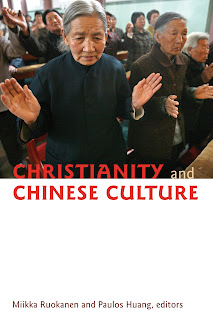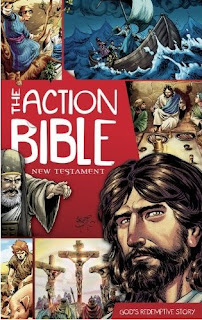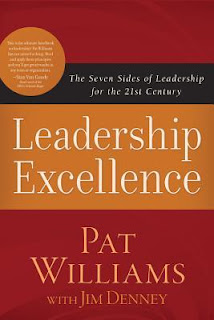TITLE:
Christianity and Chinese Culture
AUTHOR/EDITOR: Miika Ruokanen and Paulos Huang
PUBLISHER: Grand Rapids, MI:
Eerdmans, 2010, (384 pages).
ISBN: 978-08028-6556-4

This publication is a collection of conference materials presented during the 2003 Sino-Nordic conference with the same name as the title of this book. Prepared by scholars, theologians, Confucianists and Christian contributors, this volume attempts to bring the best of 'human-oriented Confucianism' and 'religious vitalism of Christianity.' It believes that Confucianism and Christianity needs each other. The former cannot deal with the deeper religious needs of the Chinese people. The latter needs a proper understanding and appreciation of Confucianism in order to be relevant and be appreciated in the Chinese culture. More importantly, it shows how the Chinese authorities are opening up to the benefits of religion, and that religion is 'not harmful to society.' Instead, there is much good that Christianity can bring about in the social wellbeing of China. This represents a great opportunity for Christians to work with the Chinese people to bring about mutual benefits.
It attempts to cover three broad areas. Part One looks back at the traditional frameworks of Confucianism and Christianity in China. Eight Chinese scholars present largely conciliatory papers that emphasize commonness, similarities, and compatibilities between the Chinese and the Western cultures. There are similarities like motivation for moral good works, recognition of some kind of evil and original sin, similar attributions to a Higher Being, and inter-religious dialogues. Frequently, the Chinese scholars point to the positive missionary example of Matteo Ricci, who himself embraced Confucian values and ethics. Interestingly, according to one scholar, Christianity seems to be more favourably accepted than other religions. One paper talks about the religious conversions of Lin Yutang. When Lin finds a conflict between Chinese culture, Taoism and Christianity, he chooses humanism and leaves Christianity. Thirty years later, after recognizing the flaws and limits of humanism, he returns to Christianity. One particularly interesting paper is how folk religions, pragmatism, secularism, rationalism, influences the attitudes of Chinese people toward Christianity. Chinese culture has been both an influence as well as a limit to the spread of orthodox Christianity.
Part Two comes back to the present state of how the Chinese people (or scholars) perceive Christianity. There is a strong sense of seeing Christianity from the eyes of Chinese culture, rather than vice versa. In other words, the scholars continue to find common ground through 'comprehensive theology' by locating a 'mean.' The premise is that the mean of Chinese culture, and the mean of Christianity will intersect. It is still very much a 'balanced' approach that resembles the Taoist yin-yang philosophy. One paper offers much food for thought. In
The Contextualization of Chinese Christian Theology, Yang Huilin argues that Christianity can be contextualized through language immersion, through humanities studies, through research into the present faith communities, and an understanding of what atheism means. For the West, atheism is antagonistic. For the Chinese, atheism is more of an 'indifference.' In response, Western theologians like Thor Strandenaes point out the 'counter-culture' nature of Christian theology.Wang Xiaochao gives 5 misunderstandings of Christianity made by the academic circles in China; namely, 1) misunderstanding the origins of Christianity, 2) Misunderstanding the relationship between Christianity and Roman Empire; 3) Misunderstanding the link between Christianity and Western philosophy; 4) Misunderstanding Christianity and the events in the Middle Ages; 5) misunderstanding Christianity and modernism. Dr Choong Chee Pang, former principal of Trinity Theological College in Singapore gives a dual response. On the one hand, he commends Xiaochao for his concise identification of the 5 misunderstandings. On the other hand, Choong says that any misunderstandings less than a biblical foundation, will remain very much a misunderstanding. This is particularly illuminating. One very down-to-earth paper deals with the practical difficulties of people living in China. With the rise of pluralism in churches, the rising rich-poor divide in society, the materialistic, pragmatic, secular society, the challenge for urban Chinese is to find a sense of spirituality. Gao Shining admits that Christians who have 'strong faith' can overcome these challenges. Those who are interested in political and social place of Christianity in China will appreciate Li Quiling's paper which touches upon how the Chinese view religion in society.
Part Three looks to the future challenges. Deng Fucun's paper explains why 'conservative theological thinking' may not work as well as the three-self patriotic church theology. The key point is that Chinese culture prefers a middle ground, and any theologies that push to any extremes will be rejected in Chinese society. Of all the three parts, this final part is perhaps the most challenging because it pushes fundamental Christianity to the borderline (even over the line) of compromising the faith, in favour of cultural relevance and acceptance. While the West grapples between Christ and Culture, as far as Christianity in China is concerned, there is another layer: Christ and China.
My Thoughts
I have three reactions when I read this volume. Firstly, it is one of disappointment because diplomacy seems to come first, critical scholarship that we are used to seeing in academic circles appears secondary. The bulk of the essays tends to prefer diplomatic tact over critical engagement with biblical principles. Intellectual vigour is perhaps subservient to the higher purpose of searching for common grounds. A majority of the scholars seem to prefer the positive messages, even claiming that Christianity is not as contradictory as many people have thought. At least the responses by the European and American scholars are a little more engaging with alternative, even opposing views. It seems like the Chinese scholars themselves tend to toe the middle ground normally, and if forced to choose, they will tend to interpret Christianity from the eyes of Chinese culture rather than from biblical grounds. It takes the Nordic responses to bring out the non-Chinese perspectives.
Secondly, the representations are lopsided toward European and Chinese scholarship. Out of the 33 contributors, only 2 are from North America. Considering North America as a major world player, it is unusual for a work like this to be limited to Chinese and Scandinavian circles. Thirdly, this book presents many windows to help Westerners understand Chinese culture a little more. This point is perhaps worth the price of the book.
All in all, in view of the lack of literature and materials on Chinese culture and Christianity in the English language, this book is a welcome addition. In order to garner a wider acceptance, such sino-Christian studies need to be more global in outlook, and the interactions need to have a greater degree of biblical foundations. What about the Chinese diaspora? What about the re-integration of Chinese scholars trained in the West? What about Western expatriates or missionaries working in China?
My main critique of this book is basically this. The contents do not exactly reflect 'Christianity and the Chinese Culture.' I feel that a more accurate title is, "Christianity seen through the eyes of Chinese Culture." There is a place for diplomacy and tact. However, for any work to be academically rigourous, deeper critical scholarship and more alternative views are needed. Perhaps, the reserved manner of scholarship from the Chinese contingent is in itself a picture of how the Chinese approach life.
Ratings: 3.75 stars of 5.
conrade












